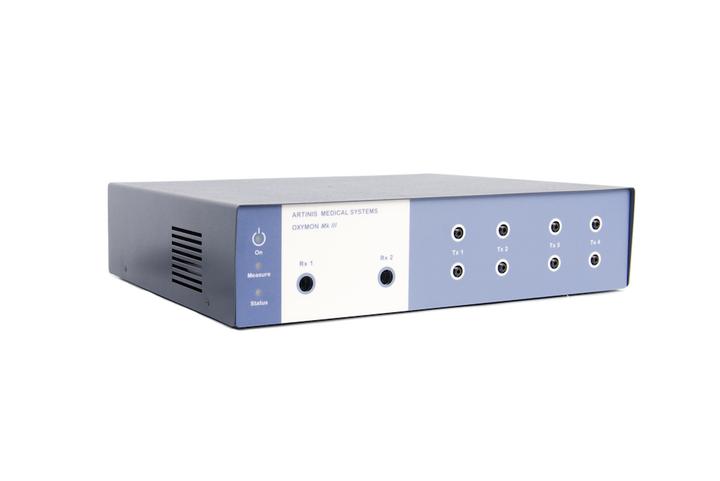
Publications using the OxyMon
Aroma of textitGenius Essential Oil Blend Significantly Enhances Cognitive Performance and Brain Metabolism in Healthy Adults
This double-blind positive-controlled study investigated the potential for the aroma of a novel blend of essential oils, Genius to enhance cognitive performance and mood in healthy adults, and whether any such benefits might be related to changes in …
Assessment of Brain Cortical Activation in Passive Movement During Wrist Task Using Functional Near Infrared Spectroscopy (fNIRS)
Purpose: Nowadays, the number of people diagnosed with movement disorders is increasing. Therefore, the evaluation of brain activity during motor task performance has attracted the attention of researchers in recent years. Functional Near-Infrared …
Neuromuscular Electrical Stimulation During Hemodialysis Enhances Exercise Capacity in Patients with End-Stage Renal Disease: A Pilot Randomized Controlled Trial
Background: Exercise capacity is markedly impaired in patients with end-stage renal disease (ESRD) due to neuromuscular dysfunction and reduced oxygen delivery. This study aimed to investigate the effects of NMES during HD on exercise capacity in …
Acute effects of ischemic preconditioning and isometric exercise on blood pressure in prehypertensive males
Objective This study investigates whether 5-min ischemic preconditioning (IR5) more effectively reduces submaximal exercise blood pressure and improves muscle oxygenation compared to 2-min ischemia (IR2) or 2-min isometric priming (IM2). Methods …
Muscle and cerebral oxygenation during exercise in fibromyalgia: a near-infrared spectroscopy study
Purpose We studied muscle and brain oxygenation during submaximal and peak exercise in patients with fibromyalgia (FM), a condition characterized by pain and fatigue, compared with age-matched healthy controls (CON). Methods The participants (FM, n = …
The effect of automatic speech recognition on Iranian interpreters' cognitive load: An fNIRS study
In the dynamic landscape of language interpreting, the integration of technology has ushered in a new era, marked by the advent of computer-assisted interpreting (CAI) tools. However, while the promise of improved communication through these tools is …
Diverse and distributed haemodynamic effects of theta burst stimulation in the prefrontal cortex
Background Theta Burst Stimulation (TBS) is a form of non-invasive brain stimulation that can induce neuroplastic changes in the underlying intracortical areas. It has significant potential in clinical and research settings for modulating cognitive …
Effects of blackcurrant juice on pre-frontal cortical haemodynamics and cognition in healthy young adults
Background Evidence from randomised controlled trials demonstrates the modulatory effects of polyphenol consumption on the vascular system including improvements to cortical blood flow (CBF), microvascular blood flow, and large artery plasticity. …
Identifying Traumatic Brain Injuries Using a Morlet Wavelet fNIRS Analysis in Role of Care 1 and 2 Environments: A Feasibility Study
Introduction Traumatic brain injury (TBI) is a significant health concern, particularly in military and sports settings. This study investigated the use of functional near-infrared spectroscopy (fNIRS) to identify TBI in Role of Care (ROC) 1 and 2 …
Impact of Hypertrophy-Focused Resistance Training on Mitochondrial Capacity: A New Perspective Through Near-Infrared Spectroscopy
This study aimed to compare the oxidative capacity of resting skeletal muscle between experienced natural bodybuilders and untrained individuals, using near-infrared spectroscopy (NIRS). Thirty-four male subjects participated voluntarily and were …
Cardiac workload and skeletal muscle oxygenation during incremental exercise in healthy subjects
We hypothesized that skeletal muscle oxygenation, measured by Near-infrared spectroscopy (mNIRS), is associated with cardiac workload during incremental exercise. Healthy subjects (n = 30, age 27 ± 6, 15 females) performed a maximal exercise test …
Effects of Proteinuria on Cerebral and Muscle Oxygenation and Microvascular Reactivity in Patients With Pre-Dialysis Chronic Kidney Disease: A Post-Hoc Analysis
Introduction Vascular dysfunction is a hallmark of chronic kidney disease (CKD), with previous studies showing progressively deteriorating microvascular reactivity in skeletal muscles with advancing CKD stages. Additionally, cognitive impairment is …
Multimodal EEG-fNIRS Classification as a Clinical Tool for Bipolar Disorder Diagnosis
Bipolar disorder (BD) is a complex mood disorder characterized by recurrent depressive and manic/hypomanic episodes, accompanied by significant cognitive dysfunction and emotional dysregulation. Accurate and timely diagnosis, especially the …
Similar improvements in skeletal muscle oxidative capacity after moderate (10 RM) and high repetition (20 RM) resistance training
Objectives This study investigated whether six weeks of resistance training to concentric failure performed with either a moderate (10-repetition maximum) or high (20-repetition maximum) repetition range enhances skeletal muscle oxidative capacity, …
The acute effect of two exercise modalities on neurocognitive responses in postmenopausal women: A randomized controlled trial
Menopause-related cognitive decline, often worsened by vasomotor symptoms (VMS), might be mitigated by high cardiorespiratory fitness (CRF). Although acute exercise supports neurocognitive function, its effects vary by exercise and individual …
Inspiratory Muscle Warm-Up and Perceptual, Physiological, and Performance Outcomes During Exercise in Normoxia and Hypoxia
Introduction: Some evidence shows that an inspiratory muscle warm-up (IMW) could enhance exercise performance; however, outcomes are mixed, and the mechanistic basis is unclear. Therefore, our purpose was to examine how IMW affects the sensory and …
A Randomized Placebo‐Controlled Clinical Trial Exploring the Short‐Term Cognitive and Cerebrovascular Effects of Consuming Peppermint Tea: A Mediation Study
The cognitive‐enhancing effects of peppermint have been widely reported. Vasodilation, causing an increase in cerebral blood flow (CBF) in the prefrontal cortex, has been implicated as a possible mediator. We tested this here. A total of N = 25 …
Mitochondrial and cardiovascular responses to aerobic exercise training in supine and upright positions in healthy young adults: a randomized parallel arm trial
Objectives Aerobic exercise training can increase skeletal muscle mitochondrial content. Supine exercise training with legs above the heart potentially augments these increases. However, the impact of supine exercise training on mitochondrial …
Impact of two different periodized aerobic training on acute cerebrovascular response and cognitive performance in coronary heart disease patients
The aim of this study was to measure the effects of chronic and acute aerobic exercise at two different intensities on cognitive performance and cerebrovascular response in coronary heart disease (CHD) patients. Thirty‐five CHD patients completed two …